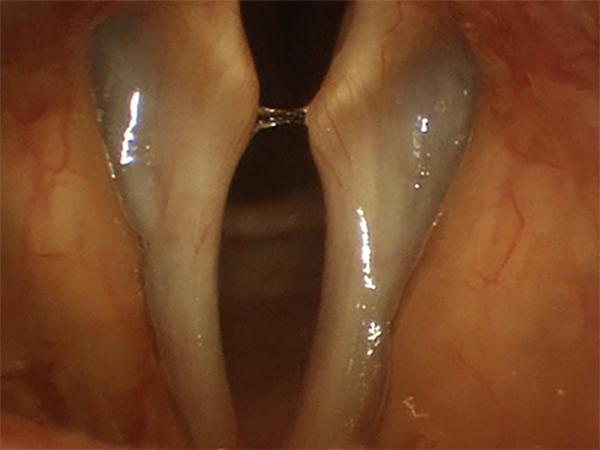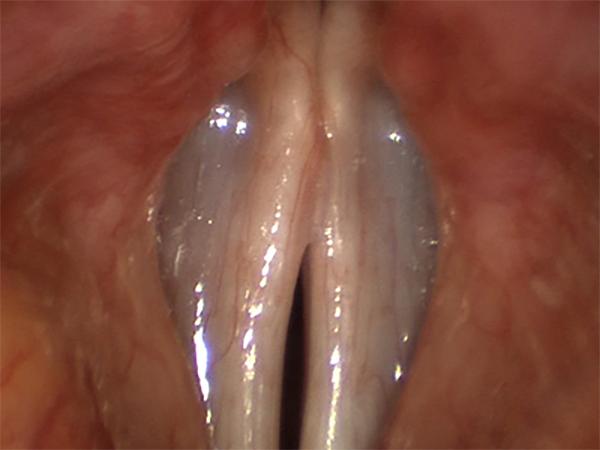Whether you see us in-person or by Video Visit, we're here for you. See how we're keeping you safe.
The larynx and vocal folds age along with the rest of the body, affecting multiple aspects of vocal fold anatomy and function. The muscle of the vocal fold atrophies, much like muscle elsewhere in the body. The flexible tissues that are responsible for vocal fold vibration during voicing (known as the superficial lamina propria) become thinner, stiffer and less pliable. In addition, tremor of the larynx may add a wobbly quality to the voice of the elderly, similar to the way hands may be noted to shake. Together, these changes sometimes result in a voice which is perceived as sounding “old”.
Changes related to age vary a great deal from person to person, both in severity and time of onset. Some individuals may retain a resonant, normal-sounding voice deep into their eighties, whereas others begin to sound “old” as early as in their fifties. We do not know what accounts for this variation, but genetics may determine and account for patterns of vocal aging.
Age-related voice change is one of the most intriguing topics in voice medicine, and a great deal of research remains to be conducted before this phenomenon is fully understood.
In general, a high-pitched, "reedy" roughness in the voice is considered characteristic of advanced age, along with a shaky quality. There may also be a loss of projection and resonance, most evident when a person tries to be heard over background noise or from one room to another in a house.
Under normal circumstances, the edge of the vocal fold stretches in a straight line between its attachments to cartilage in the front and back of the larynx. Atrophy of the vocal fold muscle and thinning of the superficial vibratory tissues generally causes the edge to take on a scalloped appearance.

Thinning of vocal fold tissues causes the vocal fold margin to appear scalloped or concave.

Normal projections of cartilage appear to stand out as abnormal masses in these thinned vocal folds.
In addition, the vocal folds seem thinner and less plump. The cartilages are more starkly outlined, and in particular, the vocal process (a point of the arytenoid cartilage at the back of the vocal fold) may stand out. Occasionally, this is mistaken for a mass, like a polyp or a cyst.
During voicing, the vocal fold edges do not come together in the middle because they have lost bulk. This produces a gap between the vocal folds in the shape of a spindle.

Thinned vocal folds are not able to close completely during voicing, and leave a characteristic spindle-shaped gap.
This spindle-shaped gap has been accepted among otolaryngologists as the definitive sign of age-related voice change. One should be aware that there can be other reasons for such a gap, and also that the gap alone is not the whole problem underlying age-related voice changes.
Physicians once thought that injecting the vocal fold with a bulking substance, such as collagen or fat, was all that was needed to restore voice quality in a larynx that had undergone age-related change. Today, most understand that while such an injection can help, it is usually only a partial solution, because the problem is typically more than simple muscle shrinking.
It is most prudent to begin treatment of age-related voice changes with a course of voice therapy. Mild changes may be overcome with improved voicing technique and some deliberate, but not inconvenient, effort on the part of the patient.
Should voice therapy alone prove unsatisfactory, vocal fold injection may be considered. The principle objective of this treatment is to restore lost bulk to vocal fold muscle, and thereby improve the closure of the vocal folds during voicing, making the voice both stronger and less effortful. However, injection does not remedy changes that have occurred in the vibratory tissues of the vocal fold, so a “perfect” voice is not typically produced with such a procedure. In addition, most vocal fold injectables are temporary; they are absorbed after a certain period of time. Individuals should speak to their laryngologist regarding the advisability of the procedure, the choice of injectable, and how long a benefit to the voice can reasonably be expected to last.
Ideally, it would be possible to replace aged vibratory tissues with new material, but this type of tissue remains a subject for research investigation at the moment. It is entirely possible that superior results will be achieved once this research produces material for human use.
Years ago, physicians introduced the idea of a “voice lift” – a surgical procedure to rejuvenate the voice, similar in concept to a face lift. In fact, this was nothing more than vocal fold injection, a procedure which had been used for other problems like vocal fold paralysis for more than fifty years. The “voice lift” is more of a marketing maneuver than a medical breakthrough. In addition, the notion of “voice lift” suggests that remedying a voice problem is basically a cosmetic procedure, an idea that remains hotly debated today, in particular because it has practical implications for health insurance coverage.